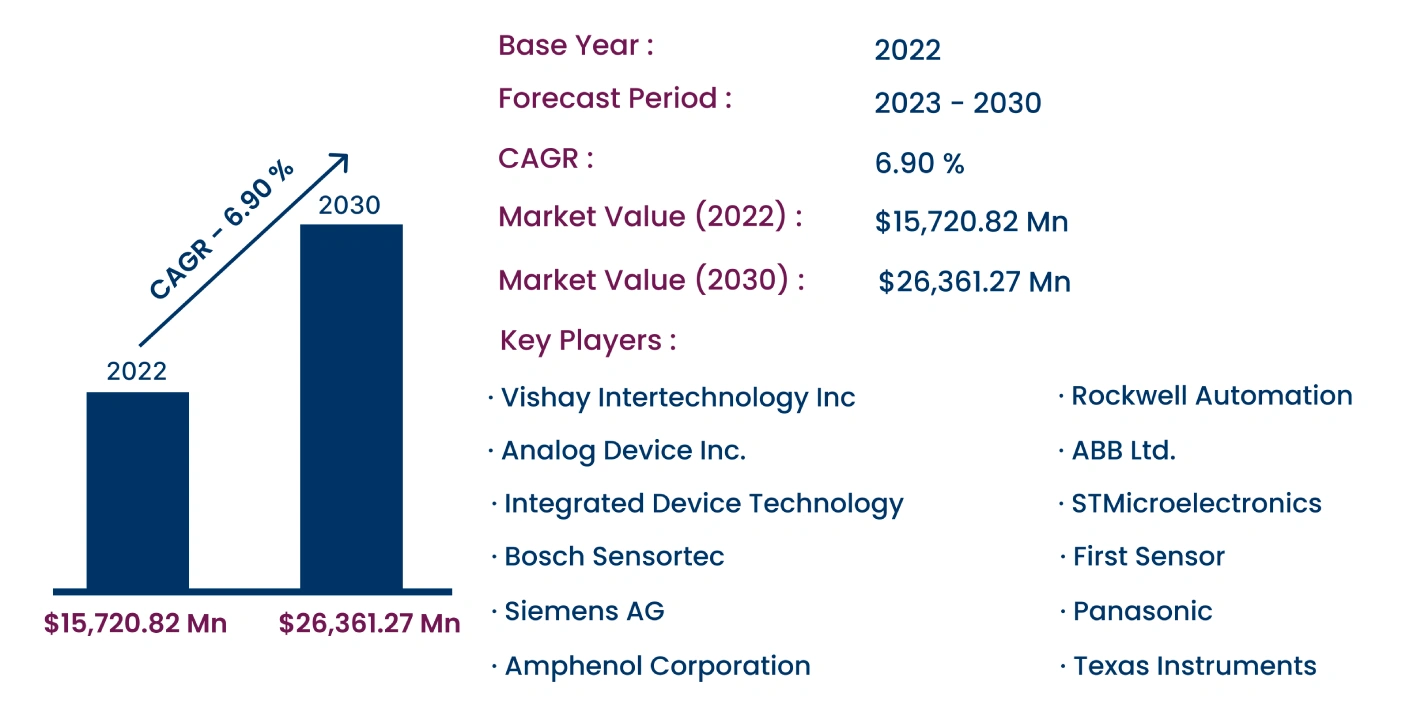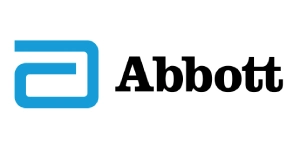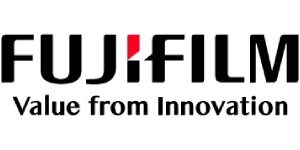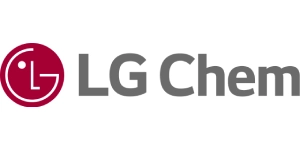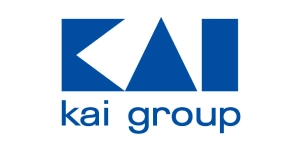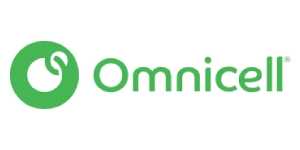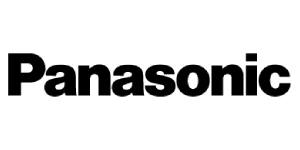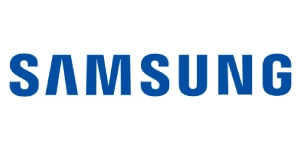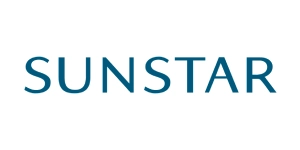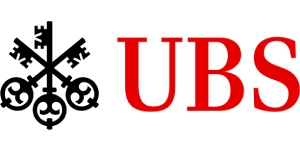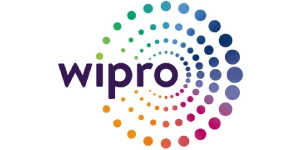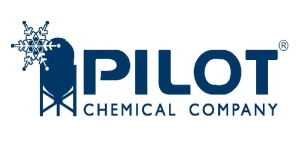Global Factory Automation Sensor Market to Reach USD 26,361.27 Million by 2030 | CAGR of 6.90%
Category : Semiconductor And Electronics | Published Date : Oct 2024 | Type : Press Release
Factory Automation Sensor Market Scope & Overview:
As per the Consegic Business Intelligence newly published report, theFactory Automation Sensor Market was valued at USD 15.72 Billion in 2022 and is projected to reach USD 26.36 Billion by 2030, growing at a CAGR of 6.9% from 2023 to 2030. Factory automation sensors, which include proximity, temperature, pressure, vibration, and vision sensors, are integral to industrial automation. These sensors monitor physical parameters within factories, providing real-time data that improves safety, quality, and productivity.
The report comprises the Factory Automation Sensor Market Share, Size & Industry Analysis, By Type (Proximity Sensor, Temperature Sensor, Pressure Sensor, Vibration Sensor, Vision Sensor, Humidity Sensor, Others), By End-Use (Pharmaceuticals, Industrial Automation, Oil & Gas, Chemicals, Energy & Power, Automotive, Food & Beverages, and Others), and By Region (North America, Europe, Asia-Pacific, Latin America, Middle East & Africa), and Forecast, 2023-2030.
The report contains detailed information on Factory Automation Sensor Market Trends, Opportunities, Value, Growth Rate, Segmentation, Geographical Coverage, Company Profile, In-depth Expert Analysis, Revenue Forecast, Competitive Landscape, Growth Factors, Restraints or Challenges, Environment & Regulatory Landscape, PESTLE Analysis, PORTER Analysis, Key Technology Landscape, Value Chain Analysis, and Cost Analysis.
The growing influence of industrial automation and demand from the automotive sector for advanced automation are key drivers of the market. In addition, integration of AI and IoT technologies within automation sensors presents new growth opportunities.
Segmental Analysis :
Based on type, the market is segmented into proximity sensor, temperature sensor, pressure sensor, vibration sensor, vision sensor, humidity sensor, and others.
- Proximity sensors held the largest share at 25.4% in 2022 due to their extensive application in detecting object presence and position, particularly in automotive and pharmaceutical sectors.
- Vision sensors are projected to grow the fastest, with their use in quality control and defect detection in industrial settings benefiting from advancements in AI and image processing.
Based on end-use, the market is segmented into pharmaceuticals, industrial automation, oil & gas, chemicals, energy & power, automotive, food & beverages, and others.
- Automotive accounted for the largest market share in 2022, driven by the increasing adoption of automation for electric vehicle production and environmental efficiency initiatives.
- Industrial automation is anticipated to witness the highest growth, supported by the global trend toward smart factories, enhancing efficiency, productivity, and safety.
Based on regions, the global market is segmented into North America, Europe, Asia-Pacific, Middle East & Africa, and Latin America.
- North America led the market in 2022, with robust technological infrastructure and high adoption of smart manufacturing practices.
- Asia-Pacific is expected to grow the fastest, driven by rising industrial output and government initiatives to boost automation in countries like China and India.
| Report Attributes | Report Details |
| Study Timeline | 2018-2030 |
| Market Size in 2031 | USD 26.36 Billion |
| CAGR (2024-2031) | 6.9% |
| By Type | Proximity Sensor, Temperature Sensor, Pressure Sensor, Vibration Sensor, Vision Sensor, Humidity Sensor, Others |
| By End-Use | Pharmaceuticals, Industrial Automation, Oil & Gas, Chemicals, Energy & Power, Automotive, Food & Beverages, Others |
| By Region | North America(U.S., Canada, Mexico) Europe(U.K., Germany, France, Spain, Italy, Russia, Benelux, Rest of Europe) APAC(China, South Korea, Japan, India, Australia, ASEAN, Rest of Asia-Pacific) Middle East & Africa(GCC, Turkey, South Africa, Rest of MEA) LATAM(Brazil, Argentina, Chile, Rest of LATAM) |
Top Key Players & Competitive Landscape :
The competitive landscape encompasses major innovators, aftermarket service providers, industry giants, and niche players, all of which are thoroughly examined by Consegic Business Intelligence in terms of their strengths, weaknesses, and value-addition potential. This report includes detailed profiles of key players, market share analysis, mergers and acquisitions, resulting market fragmentation, and emerging partnership trends and dynamics.
List of prominent players in the Factory Automation Sensor Industry:
- NXP Semiconductor NV
- Infineon Technologies AG
- TDK Corporation
- TE Connectivity
- General Electric
- Vishay Intertechnology Inc.
- ABB Ltd.
- Analog Device Inc.
- Integrated Device Technology
- Bosch Sensortec
- Siemens AG
- Amphenol Corporation
- STMicroelectronics
- First Sensor
- Panasonic
- Texas Instruments
- Honeywell International Inc.
- Rockwell Automation
- PEPPERL+FUCHS
Recent Industry Developments :
- In August 2023, NXP Semiconductors, Robert Bosch GmbH, and Infineon Technologies jointly invested in the European Semiconductor Manufacturing Company (ESMC) in Germany to advance semiconductor manufacturing services.
- In October 2022, OMRON launched its FH-SMD series of 3D vision sensors for robotic arms, enhancing accuracy in automated quality inspection.
